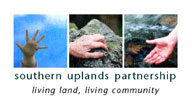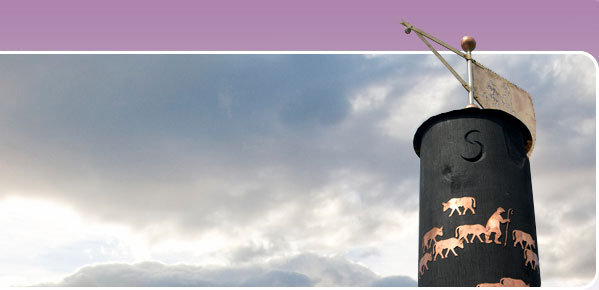About SOSCT
 SOSCT was an innovative partnership project involving British Horse Society Scotland, local community path groups, Scottish Borders Council and Solway Heritage under the umbrella of Southern Uplands Partnership (SUP).
SOSCT was an innovative partnership project involving British Horse Society Scotland, local community path groups, Scottish Borders Council and Solway Heritage under the umbrella of Southern Uplands Partnership (SUP).
Capital work to improve the SOSCT routes was funded by Heritage Lottery Fund as part of the Tweed Rivers Heritage Project, European Regional Development Fund, Scottish Natural Heritage and Forestry Commission Scotland.
How did SOSCT come about?
The South of Scotland has a rich heritage of tracks and trails, drove roads and old Roman roads, many dating back thousands of years. The routes along which Roman armies once marched, used for Reiver’s raids and along which drivers herded their cattle and sheep to market are as essential a part of the area’s heritage as its characteristic rivers, settlements, historic buildings and field systems. Although some of these routes were still discernible on maps or from the air, padlocked gates, barbed wire fences, crumbling dykes, blanket afforestation, deteriorating drainage and lack of maintenance meant that by 2000AD very few were passable on the ground, and usually only on foot.
British Horse Society Scotland (BHSS) had for some time been striving to restore key routes and develop longer distance strategic riding routes in the Scottish Borders. Meanwhile, local communities in Tweeddale in the Scottish Borders were busy undertaking community consultations to identify priorities for local path network development. As with many other projects, the limiting factors on taking forward ideas were available time and money.
Tweed Forum’s invitation in May 2000 for applications which might be considered for inclusion in their Phase II Heritage Lottery Fund (HLF) bid offered a unique opportunity to take forward proposals for an inter-linked network combining strategic longer-distance route priorities identified by BHSS, and local routes identified as priorities by local communities around West Linton, Peebles, Innerleithen and Walkerburn. The combined proposals were christened the Tweed Trails project.
Phase 1 – Tweed Trails Feasibility Study
HLF, Scottish Natural Heritage (SNH) and Paths for All Partnership provided the necessary financial assistance to buy in professional input to survey proposed routes and produce detailed, costed specifications for the routes already identified by BHSS and local community groups. Vyv Wood-Gee, an independent countryside management consultant, was appointed to undertake the feasibility study, and to produce phased proposals for implementation over three years. The study, which was completed in February 2002, was essential not only to securing funding, but to providing firm foundations for subsequent implementation and project management.
Phase 2 – Securing Funding
Capital funding for implementing proposals for routes in the Scottish Borders was confirmed through HLF, SNH and Forestry Commission, but this still left a shortfall. European Regional Development Fund (ERDF) was identified as the most likely source of further funding, but was dependent on proposals spanning the South of Scotland rather than being limited to the Borders, and on demonstrating unique economic benefits. This was achieved by combining the Tweed Trails proposals with the recommendations of an earlier feasibility study commissioned by BHSS for a linear route linking west to Ae in Dumfries and Galloway into one single project, and on a further study to demonstrate the potential for equestrian tourism development based on the resultant route network.
Phase 3 – Implementation
Vyv Wood-Gee was appointed project manager to co-ordinate implementation of all of the work in the Scottish Borders, working closely with BHSS and local community groups through the Tweed Trails steering group, chaired by SUP. Implementation of the SOSCT route in Dumfries and Galloway was co-ordinated by Solway Heritage.
Major capital work such as drainage and gate replacement was undertaken by local contractors. In Tweeddale, local community volunteers played an essential role in waymarking paths, and continue to do so in monitoring the paths.
Subsequent promotion of the Tweed Trails and SOSCT routes for equestrian use, including further development of linked accommodation for horse and rider and revision of the SOSCT leaflet, has been undertaken through BHSS.
